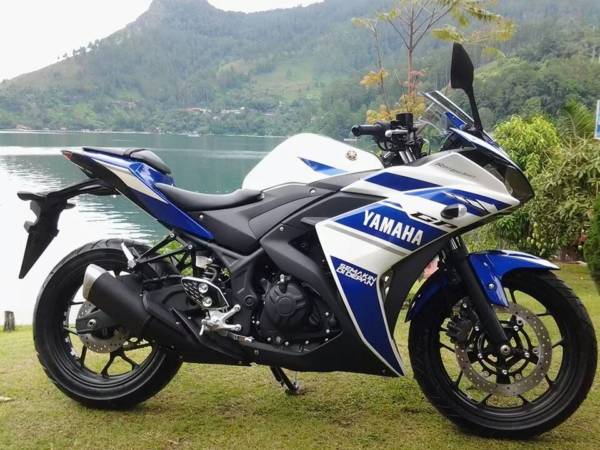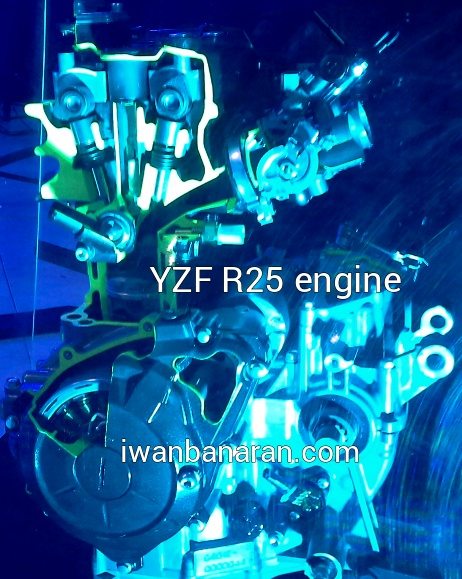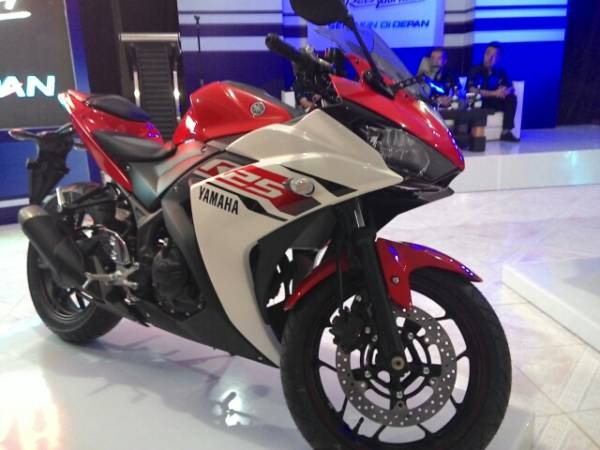So this is it. Yamaha Indonesia has kept their word and finally unveiled the YZF-R25 to the public. We have already covered the R25 in exhaustive detail before, bringing you the first updates from our Indonesian friends as and when they happened. But now that the time for spy shoots, grainy cellphone images, and speculative calculations are over, let’s take a closer look at what the Yamaha R25 brings to the table.
First things first, the motor. The R25 is powered by a liquid-cooled, fuel-injected 8 valve DOHC twin-cylinder engine producing 36PS of peak torque at 12000 rpm and 22.1Nm of peak power at 10000rpm. True to the YZF family tradition, the engine is a 60.0 x 44.1 mm high-revving unit, also incorporating the DiASil forged piston cylinder that we first saw in the R15.
There were groans of disappointment from some quarters when it was first announced that the R25 wouldn’t be getting the perimeter frame that has almost become a signature for Yamaha’s supersport bikes, no matter the displacement. The R15 gets it, and so does the R125, both smaller machines. In contrast, the R25 employs a traditional diamond frame, with the engine being a stressed member of the frame. This type of construction is common in small to mid-engined motorcycles thanks to its simple structural design, serviceability, and light weight. Yes, it is not as good as the track-honed perimeter frame, but it will do very fine for a 250cc. And keep costs down too.
41mm telescopic forks upfront and a Monocross suspension at the rear handle suspension duties. Monocross is basically what Yamaha calls their monoshock suspension systems, just like Honda with their Pro-link and Kawasaki with their Uni-Track.
It is again not as advanced as the link-type Monocross suspension on the R15, which offers a uniform ride quality regardless of the load and prevents the bike from bottoming out on tricky bumps. We really would have loved it if Yamaha had given us upside-down forks (USDs) in place of the conventional telescopic forks. The 2014 R125 has got it, so keep your fingers crossed for this one.
Keeping in mind the fact that Asians are shorter on average, Yamaha has kept the seat height at a manageable 780mm. Wheelbase is 1380mm, and the entire bike weighs in at 166 kgs (kerb).
Braking is via 298mm floating disc, dual piston calipers upfront and a single 220mm at the rear.
Design is a deeply personally thing, and what works for one might not work for the other. As they say, beauty lies in the eyes of the beholder.
The production-spec Yamaha R25 has changed substantially from the prototype that we first say at the Tokyo Motor Show last November and the Indian Auto Expo earlier this year. Back then, it looked like a meticulously scaled down version of the M1 racebike, even down to the livery and that sweet Akrapovic exhaust can. The absence of lights and other accessories also helped.
PIC: The Yamaha R25 prototype at the Tokyo Motor Show in Nov. 2013
In its transition to the street, the R25 has lost some of the smooth lines of the prototype that we saw earlier. The floating side panels are still classical Yamaha and they do it better than any manufacturer out there. From the front, the twin headlamps resemble the ones on the Ducati 1199 Panigale, brooding and staring down at you. The difference here is that the R25 also has a centrally mounted pilot lamp. I initially hated the Panigale’s headlamps, considering it to be less beautiful than the 1098’s, but it has grown onto me over time. Maybe it will be the same with the Yamaha r25 too, but it is something that I am in two minds about for now.
We always knew that the clip-on handlebars mounted directly to the forks that we saw in the prototype wouldn’t make it to production. In their place are taller clip-ons mounted on risers, for a less demanding riding posture.
The instrument console employs the traditional analogue tacho/digital everything else layout that we see in almost all sportbikes on the market right now. It is a bit too angular and slash cut for my tastes, and I wish that the lines would have been a bit more smoother, like the rest of the bodywork. But that’s just nitpicking to an extreme, right?
>>>Click here to read page 2 of this article>>>




